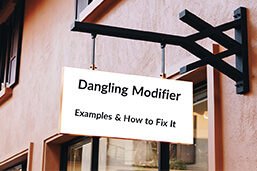
A dangling modifier is a common grammatical error that occurs when a modifying phrase or word in a sentence is unclear or ambiguously linked to the noun it’s supposed to modify. This typically results in a sentence that can be confusing, misinterpreted, or even unlogical. Developing an understanding of dangling modifiers, their potential impact, and the methods to detect and correct them is an essential part of mastering written English language rules. Learn more in this article.
Definition: Dangling modifier
A modifier is a word or phrase that clarifies or gives more information about another part of a sentence. However, a dangling modifier can occur when the intended subject of the modifier isn’t present in the sentence, and instead, another subject replaces the intended one.
They often appear as introductory phrases that are not connected to the appropriate noun or subject in the sentence. Here is a table with an example of a dangling modifier and the correct version:
| Dangling Modifier ✘ |
Corrected Version ✓ |
| After reading the novel, the story remains questionable | After reading the novel, I find the story questionable |
| The exam was hard, not having studied the unit in advance | They failed the exam, not having studied the unit in advance |
| Searching in his car, the phone could not be found | Searching in his car, he could not find the phone |
Identifying a Dangling modifier
To identify a dangling modifier, it is important to pay attention to the placement of the modifier in the sentence and check if it is clearly linked to the noun it is modifying. A sentence that has been modified correctly should position the modifier so that it accurately describes the noun.
Fixing a Dangling modifier
There are two main methods for fixing a dangling modifier:
- Revising the main clause
- Revising the modifier clause
Both methods aim to clearly link the modifier to the noun it is modifying and remove any ambiguity from the sentence.
Revising the main clause
This method involves rephrasing the sentence in a way that the modifier will be linked clearly to the noun it is modifying. It can be done by reordering the words in the sentence or adding a subject to the sentence.
Revising the modifier clause
A modifier clause is a clause that modifies or describes a noun or verb in the sentence. The modifier clause must be placed close to the noun or verb it is modifying to avoid confusion and to ensure proper grammar.
Below are a few more examples of incorrect modifier clauses and their corrected versions:
Note: The context and meaning of the sentence should be kept in mind while revising the main clause to avoid any miscommunication or misinterpretation.
Printing Your Thesis With BachelorPrint
- High-quality bindings with customizable embossing
- 3D live preview to check your work before ordering
- Free express delivery
Configure your binding now!
FAQs
A dangling modifier is a type of modifier clause that is not clearly connected to the noun or verb it is supposed to modify.
Words such as “after,” “before,” “while,” “during,” and “since” are often used to begin a modifier clause, and if they are not used correctly, they can cause a dangling modifier.
A good way is to identify the noun or verb the modifier clause intends to modify and see if it is placed close to the modifier clause in the sentence. If it is not, it may be a dangling modifier.
Yes, one tip to avoid a dangling modifier is to make sure the subject of the modifier is clear and directly relates to the subject of the sentence. Another tip is to check your sentence for any word or phrase that often leads to a dangling modifier.
